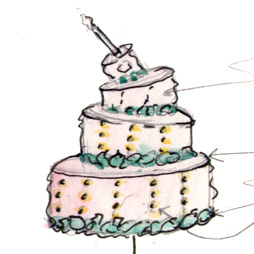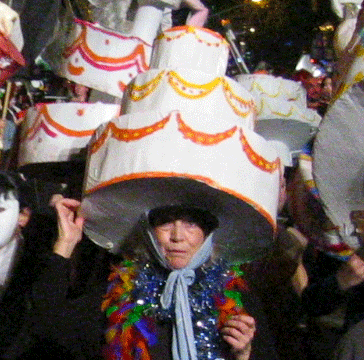Drawings and Plans |
The Cakewalk |
In counterpoint to last year’s Trickster, the Village Halloween Parade paid tribute this year to the treat. SCM borrowed a recipe from the African-American musical tradition, producing a Cakewalk that sashayed, sauntered, and strutted its way up Sixth Avenue.
Cakewalks originated among African-American slaves in the 19th Century, as prominades burlesquing the airs and pretensions of wealthy plantation owners. Like many aspects of Carnival, it was an exuberant but satyrical “ceremony of inversion” in which the have-nots have some fun at the haves’ expense. Cakewalks outlasted Slavery and outgrew the plantations where they originated, becoming a vastly popular staple in turn-of-the-century dancehalls and Vaudeville stages. Competitions were held to see who could perform the most extravagantly ridiculous promenade, offering the winning couples fine cakes as a prize. The syncopated rhythms that accompanied these wild, satyrical gaits evolved into Ragtime, and sowed the rebellious seeds of Jazz.
In our annual community workdays, 50 volunteers created confectionary headwear to adorn dozens of Cakewalking couples. The giant cakes, precariously layered and deliriously frosted teetered on dancers’ heads, as choreographer Ramona helped them strke the delicate balance between effete composure and wild synchopated abandon. The Giglio Band provided the music, accompanied by our own alluring Cello Sweet, a trio animated 14’-tall cello puppets.

